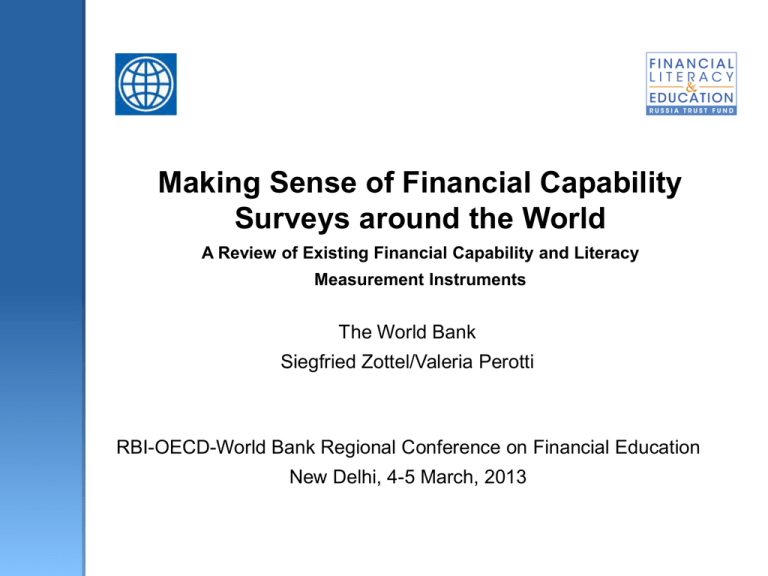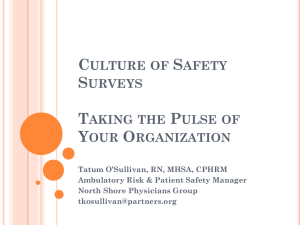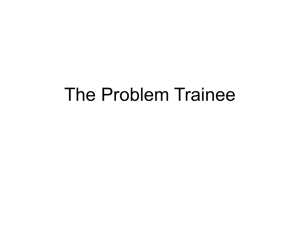Ms Valeria Perotti
advertisement

Making Sense of Financial Capability Surveys around the World A Review of Existing Financial Capability and Literacy Measurement Instruments The World Bank Siegfried Zottel/Valeria Perotti RBI-OECD-World Bank Regional Conference on Financial Education New Delhi, 4-5 March, 2013 Purpose of the Review Guide policy makers on existing measurement instruments o Useful for policy makers who prioritize Fin. Capability, Fin. Inclusion or Fin. Consumer Protection o o Describe and compare key instruments that are: • Innovative • Focused on demand-side (household vs. business) • Well established • Well documented 2 Surveys Reviewed Jump$tart FSA Consumer Awareness FinScope Findex Consumer Fraud US UK FSA WB FCCP Eurobarometer Portugal Survey of Consumers US Health & Retirement Study OECD/INFE Financial Diaries CP Kenya Ghana FSS Singapore Fiji Kenya FinAccess WB/Russia FLIT New Zealand 3 Content of the review Key questions addressed by the review: o 1. 2. 3. 4. How can a survey support policy making? What do these surveys measure and how? How can a survey be implemented properly? How to analyze and present the data to inform policy? 4 1. How can a survey support policy making? Capability Inclusion Consumer Protection • Baseline assessment of weak areas/targets • Identify potential channels for info or FE • Understand behavior related with personal or household finances • Understand knowledge/behavior relationship • Determine what products people use • Understand reasons for limited use • Understand how people use information • Understand attitudes towards fin. issues • Assess awareness of CP laws, mechanisms • Identify potential victims of fraud • Assess attitudes and trust in providers and regulators 2. What do these surveys measure and how? Financial Capability Knowledge of financial concepts Awareness of financial products and services Questions on… inflation compound interest budgeting returns on investment insurance money illusion Risk diversification Practical Know-how Financial Capability Knowledge of financial concepts Awareness of financial products and services Practical Know-how Questions on… Awareness of product existence Basic product features Advantages of using products Risks and costs Financial Capability Knowledge of financial concepts Awareness of financial products and services Practical Know-how Questions on… How to make payments How to set up a budget How to keep financial records How to open a bank account How to seek for recourse Financial Capability Behavior Attitudes Questions on… Paying bills on time Budgeting Saving Overspending Making choices Planning for old age Borrowing Dealing with unexpected expenses/income loss Financial Capability Behavior Attitudes Questions on… Reasons for or for not saving, borrowing, investing, budgeting, and choosing specific financial products Attitudes toward impulse purchases Attitudes towards the future Propensity to save Confidence in own retirement plans Financial Inclusion Behavior Questions on… Types and number of financial products used Frequency and modality of use What products are used for Ways of accessing financial services Attitudes Financial Inclusion Behavior Attitudes Questions on… Perceptions on service accessibility Barriers in accessing services Reasons for/for not using specific financial products Reasons for changing a product Consumer Protection Behavior Attitudes Experience Questions on… Actions taken to resolve issues with fin. service providers Where complaints were filed Entities consulted in case of disagreement Consumer Protection Behavior Attitudes Experience Questions on… Satisfaction with financial products and service providers Trust in service providers Confidence in resolving disputes Perceptions on financial regulators and supervisors Consumer Protection Behavior Attitudes Experience Questions on… Experience with pyramid schemes Being billed for a service not received/product not requested 4. How can a survey be implemented properly? Main approaches for survey implementation o Who should be interviewed? • Individual vs. household o How to ensure comparability over time? • Repeated cross-section vs. panel survey • Panel surveys are more time resource-intensive • Use same questions (make sure they are still meaningful!) • Employ consistent sampling methodology o How to ensure comparability across countries? • Coordinated joint efforts by all countries involved • Replicating what has been done (requires caution!) 19 How can data quality be ensured? o Developing a well-tested questionnaire • • • • Reviews of existing surveys Experts groups Qualitative testing (focus groups, cognitive interviews) Quantitative testing (pilot surveys) Sampling design o Mode of interview o 20 5. How to analyze and present the data to inform policy? Main approaches for data analysis o How to develop indicators? • Frequencies and proportions of individual questions • Combining data by creating composite scores (e.g. sum of correctly answered fin knowledge questions) • Weighted scores • Factor analysis o How to identify potential target groups? • • • • Use cross-tabulations Regressions Segmentation (by ranking people according to scores) Cluster analysis 22 THANK YOU! Contacts: vperotti@worldbank.org szottel@worldbank.org 23











